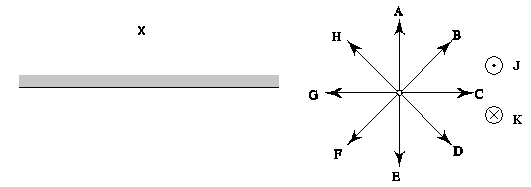
Teaching Physics with the Physics Suite
Home | Action Research Kit| Sample Problems | Resources | Product Information
Problems Sorted by Type | Problems Sorted by Subject | Problems Sorted by Chapter in UP
 |
Teaching Physics with the Physics Suite
Home | Action Research Kit| Sample Problems | Resources | Product Information |
Problems Sorted by Type | Problems Sorted by Subject | Problems Sorted by Chapter in UP |
1.(From an exam) In this problem, we will consider situations corresponding to three different long thin lines of matter containing charges:

For each of the three cases, indicate in what direction the electric and magnetic fields at the location x would point. If any of the fields are zero, write 0.
| Case | Direction of Electric Field at x | Direction of Magnetic Field at x |
| current carrying wire | ||
| rubbed amber rod | ||
| electron beam |
Now consider placing a positive charge at the location x. In one case it is stationary, while in a second case it is moving in the direction C. Indicate the direction you believe nearest to the total force the charge would feel. (Ignore gravity and air resistance.)
| Case | Direction of force on stationary + charge at x | Direction of force on + charge moving in C direction at x |
| current carrying wire | ||
| rubbed amber rod | ||
| electron beam |
Note to the instructor: This presents students a nice challenge. Many are confused about what a current is and think it carries charge. This problem clearly reveals that difficulty. Note that the last entry in the table -- the moving charge near the electron beam -- the answer is ambiguous: it depends on the charge density and the energy (speed) of the charges, since the electric and magnetic forces point in opposite directions. This is OK for a homework, but perhaps a little much to expect students to be able to handle under the pressure of an exam. (I give it, but accept A, E, or 0 as an answer.)
Not finding what you wanted? Check the Site Map for more information.
Page last modified October 19, 2002: MG03